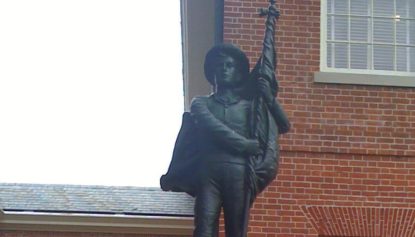
Scott lost in state and federal courts and during this time, his ownership was transferred to Irene’s brother John Sanford. Scott v. Sanford eventually came before the U.S. Supreme Court and it was there that Scott lost his case, with Chief Justice Roger B. Taney delivering the majority opinion. Taney had intended for the case to settle the debate over slavery, but the verdict had the opposite effect and is regarded as one of the catalysts to the Civil War. In 1872, amid pro-Southern sympathies in Maryland in the aftermath of the war, an 83,000-pound sculpture of Taney was placed on their State House grounds.
The Taney statue has become controversial in recent decades, and in 1990, a statue of Supreme Court Justice Thurgood Marshall was placed on the other side of the State House as a meager compromise. The issue resurfaced last year when Maryland lawmakers introduced a bill to have the Taney statue removed and stored in a museum. Today, descendants of the Scott and Taney families will gather together at the Taney statue for a historic apology and to speak against its removal. They hope to inspire reconciliation with a proposal to erect statues of Dred Scott and Frederick Douglass standing in positions of dialogue with Chief Justice Taney, along with an educational display on the Dred Scott decision and its aftermath.
The Scott and Taney families met when they were invited to participate in an audience Q&A for a one-act Actors Studio play that imagined a present-day meeting between Scott and Taney’s descendants. They remained in contact following the event, eventually reconciling publicly and vowing to work together to soothe racial tensions between Blacks and whites. They defend keeping Taney’s statue on State House grounds under the argument that Americans should not bury their history but instead learn it.
As a Jacksonian Democrat, Taney was a loud advocate for state rights. Despite these views, he ruled against Dred Scott, who was seeking to be freed under the argument that his owners had relocated to a free state. The decision in Dred Scott’s case also ruled the Missouri Compromise unconstitutional and thus prevented Blacks from pursuing freedom in states or territories where slavery had been abolished. In his opinion, Taney wrote that our founding fathers believed that Blacks were “so far inferior that they had no rights which the white man was bound to respect, and that the negro might justly and lawfully be reduced to slavery for his benefit.”
To place statues of Dred Scott and Frederick Douglass in dialogue with Chief Justice Taney does not help us learn from history, it attempts to rewrite it. It represents America’s collective efforts to distance itself from the brutal legacy of slavery. It was only a couple of years ago that a Texas mother took textbook publisher McGraw-Hill to task for referring to enslaved Blacks as workers and immigrants. Even in its apology, McGraw-Hill said it would change the wording “to describe the arrival of African slaves in the U.S. as a forced migration,” instead of using more transparent terminology such as kidnapped or stolen. The Charleston church shooting led to a call for Confederate symbols to be removed from government property and it was during that debate that opponents revealed their deliberate misunderstanding of the Civil War. With so many already attempting to discredit the role of systemic oppression in America’s history, we cannot afford to continue blurring the facts.
We can reconcile and move forward, but as we negotiate these new terms of progress, we must not settle for less than the truth. If Taney’s statue is to remain, we must be honest about the role he played in sealing the fates of so many enslaved Blacks. Future generations deserve to know how tirelessly Dred Scott fought and how the highest court in our lands conspired to defeat him. It’s wonderful that Scott’s and Taney’s descendants have managed to put history behind them, but while he was alive, Justice Taney made his stance on slavery abundantly clear. He was never open to dialogue with Dred Scott and would not have considered Frederick Douglass’ status as a free Black man legitimate. Slavery was abolished in spite of Taney’s ruling, not because of it, and to pretend otherwise only continues America’s tradition of watering down its oppressive history.
Following the ruling, the Scott family was returned to Irene Emerson, who had since married an abolitionist. After spending 11 years arguing his case, Scott and his family were freed a couple of months after the trial ended. Unfortunately, Scott’s freedom was short-lived and he died of tuberculosis the following year. Chief Justice Taney died in office in 1864, on the same day that Maryland abolished slavery.


